
When you lose muscle mass, you have a harder time managing blood sugars. Increase insulin action and improve insulin sensitivity with strength/resistance training.
When you target your muscles, your body pulls glucose from the blood stream to the muscles to be stored and used as energy (for up to 72 hours after the workout!).



Understanding the difference between Type 1 and Type 2 Diabetes
Type 1 and type 2 diabetes share the problem of high levels of blood sugar. Despite sharing a name, type 1 and type 2 diabetes are different. Here’s what you need to know.
Type 1
Type 1, the less common of the two, happens when the immune system mistakenly attacks the body’s beta cells. Beta cells, found in the pancreas, produce insulin. Once this happens, the body cannot produce the insulin needed to regulate blood glucose levels. From day one of diagnosis, type 1’s will need to supplement the loss of insulin with multiple insulin injections or an insulin pump. Type 1, formerly known as juvenile diabetes, happens in 5-10% of the cases of diabetes and is often diagnosed in children. There is no cure for this autoimmune disease and no way of reversing it.
Type 2
Type 2 is a metabolic condition formerly known as “adult on-set diabetes”. The result of muscles and tissues of the body developing a resistance to insulin. The pancreas works harder to make more insulin, fighting this resistance. The insulin-producing beta cells, located in the pancreas, begin to wear out, struggling to make enough insulin. The results are higher blood sugars. This is prediabetes and ultimately diabetes. Diet and exercise are both key components in thwarting off prediabetes or managing, possibly reversing, type 2 diabetes.
Managing Life with Diabetes
Type 1 diabetics need to follow a healthy eating plan. Counting carbohydrates and knowing their blood sugar level with each meal is vital. Calculations based on their blood sugar levels, amount of carbs in meal and insulin to carb ratio are made for dosing. Multiple blood sugar checks per day are required, or they can wear a continuous glucose monitor. Exercise is encouraged, with close attention being paid to blood sugars in order to avoid hypoglycemic or sometimes hyperglycemic reactions.
Type 2 diabetes can be managed with a low carb meal plan, exercise, and sometimes, but not always, medications. Weight loss, a healthy diet and becoming more active is recommended. Blood sugar monitoring may or may not be a part of type 2’s treatment plan (depending on Dr.) but it is highly beneficial. Knowing blood sugars gives insight on how diabetes is progressing.
Similarities Between Type 1 and Type 2 Diabetes
Glucose, carbohydrates, pancreas, there are similar sounding terms. Yet we know the two types are indeed different. Unfortunately, diabetes-related complications are common to both forms of disease. This includes neuropathy, retinopathy (eye damage) and kidney damage. Heart attack and stroke are diabetes-related as well as insufficient delivery to blood in the extremities combined with nerve damage and impaired wound healing capacity leading to limb amputations.
Managing blood sugar levels is key. To prevent or delay diabetes problems, exercise, eat a healthy diet and take medications (if needed). Research shows that complications arise from unstable blood sugar levels. This pertains to both type 1 and type 2 diabetes.



